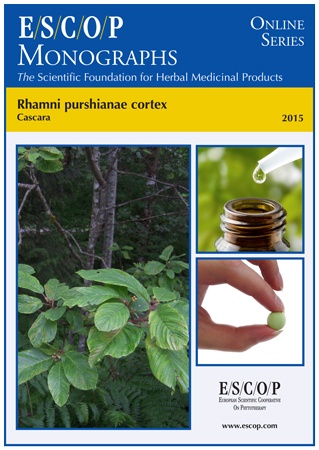 Rhamni purshianae cortex
Rhamni purshianae cortex
Cascara
Rhamnus purshianus DC. (Frangula purshiana (D.C.) A. Gray ex J.C. Cooper.)
Published 2015
Format: PDF
 Online viewing (for only €30 per year, you can view online all the monographs)
Online viewing (for only €30 per year, you can view online all the monographs)
SUMMARY:
The herbal monograph selects and summarises scientific studies and textbooks regarding efficacy, dosage and safety to support the therapeutic uses of cascara.
This herbal drug by definition consists of cascara, the dried, whole or fragmented bark of Rhamnus purshianus DC. (Syn: Frangula purshiana Cooper).
Studies with its main characteristic constituents hydroxyl-anthracene glycosides are included.
The therapeutic indication of cascara is occasional constipation.
Administration of cascara addresses dosage, duration of use; contra-indications; special warnings; special precautions for use; interactions with other medicinal products; other forms of interaction; use during pregnancy and lactation; its effects on ability to drive; undesirable effects; overdose.
In vitro experiments and in vivo experiments demonstrated the different mechanisms of action.
Pharmacokinetics of hydroxyl-anthracenes in animals gives information on absorption, metabolism and elimination.
Preclinical safety data for cascara and hydroxyl-anthracene glycosides were assessed in toxicity studies.
Safety data were assessed in human studies.
The selection of literature cited in the monograph is aimed at bringing together relevant information about the possible physiological roles of cascara and its major constituents.
KEYWORDS:
- Rhamnus purshianus DC. (Frangula purshiana (D.C.) A. Gray ex J.C. Cooper.)
- Rhamni purshianae cortex
- Cascara
- Constipation occasional